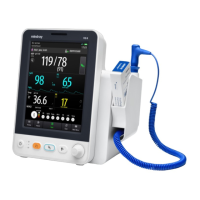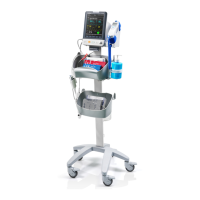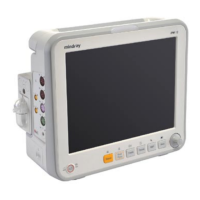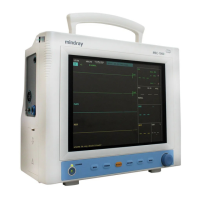VS 8/VS 8A Vital Signs Monitor Operator’s Manual D - 1
D Alarm Messages
This chapter lists only the physiological and technical alarm messages. Some messages
appearing on your monitor may not be included. In the “Cause and solution” column,
corresponding solutions are given instructing you to troubleshoot problems. If the
problem persists, contact your service personnel.
• The gas analyzer is not an apnea monitor. The safety and effectiveness of the
respiration measurement method in the detection of apnea, particularly the
apnea of prematurity and apnea of infancy, has not been established.
D.1 Physiological Alarm Messages
D.1.1 General Physiological Alarm Messages
Note:XX represents a measurement or parameter label, such as NIBP, RR, SpO
2
, PR, and so on.
D.1.2 SpO
2
Physiological Alarm Messages
Alarm
messages
Default
priority
Cause and solution
XX High Med XX value has risen above the high alarm limit or fallen
below the low alarm limit. Check the patient’s condition
and check if the patient category and alarm limit settings
are correct.
XX Low Med
Alarm
message
Default
priority
Cause and solution
SpO2 Desat High The SpO
2
value falls below the desaturation alarm limit.
Check the patient’s condition and check if the alarm
limit settings are correct.
D - 2 VS 8/VS 8A Vital Signs Monitor Operator’s Manual
D.1.3 PR Physiological Alarm Messages
D.1.4 NIBP Physiological Alarm Messages
D.2 Technical Alarm Messages
This section lists technical alarms, their default priority, responses on alarm reset, and
the actions that can be taken when an alarm occurs. Some of alarms may not be
included.
Various technical alarms respond differently when the alarm system is reset. For easy
clarification, in this section the technical alarms are classified into three categories of
response when the alarm system is reset:
■ A: technical alarms are cleared. The monitor gives no alarm indications.
■ B: technical alarms are changed to the prompt messages.
■ C: the alarm is silenced and a √ appears before the alarm message.
In the following tables, A, B, and C are used to refer to the responses on alarm reset.
Alarm
message
Default
priority
Cause and solution
No Pulse High The pulse signal was so weak that the monitor cannot
perform pulse analysis. Check the patient’s condition
and the source of the PR, such as SpO
2
sensor, and
measurement site.
Alarm message
Default
priority
Cause and solution
NIBP-S Extremely
High/NIBP-D
Extremely High/
NIBP-M Extremely
High
High The NIBP value is higher than the NIBP Extreme
alarm high limit. Check the patient’s condition
and check if the alarm limit settings are correct.
NIBP-S Extremely
Low/NIBP-D
Extremely Low/
NIBP-M Extremely
Low
High The NIBP value is lower than the NIBP Extreme
alarm low limit. Check the patient’s condition and
check if the alarm limit settings are correct.

